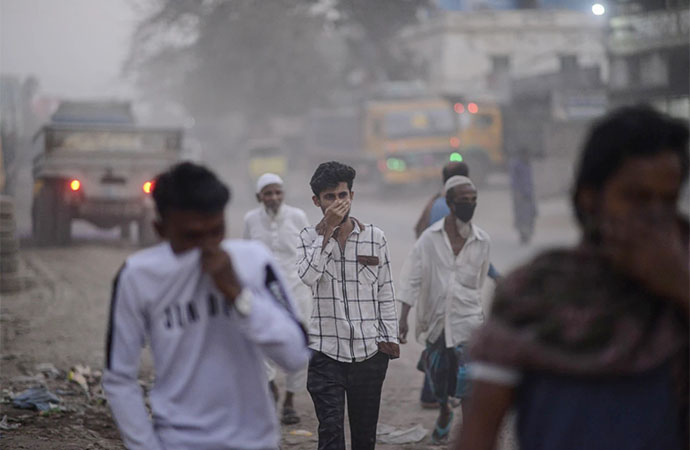Reportage

Freepik
Bangladesh has been facing increasing heat waves during summer for the last couple of years. In 2023, record-setting highs were observed across the country between April and June, with some areas reaching soaring temperatures of over 40°C. The severe heatwave peaked in early June, with weather stations recording highs of 41°C - the highest temperature recorded in the last six decades.
That has already been surpassed this year, and we now know 2024 is the hottest year yet, recording average temperatures of 40 to 42 degrees Celsius in all the divisions. The population and biodiversity of the country are at stake due to such an unprecedented catastrophe.
According to news reports, at least 23 individuals have died from heatstroke this year, and millions of people have suffered several health implications, including vomiting, diarrhoea, heat exhaustion, headache, pneumonia, shortness of breath, dehydration, etc. Some of the educational institutions temporarily closed due to the extreme heat.
This extreme weather reflects Bangladesh's environmental vulnerability and weak environmental governance. The country is already a top-listed victim of global climate change; the indiscriminate human activities that destroy its environment are worsening its plight. Academic studies have identified "massive and common" environmental crimes over the last few years. White-collar criminals clear-cut thousands of acres of forestlands, emitted harmful gases from their industries, and encroached on riverbanks. Even some government institutions have been accused of committing environmental crimes. It demonstrates that there are severe weaknesses in environmental governance in Bangladesh.
Environmental governance, a fundamental pillar of overall governance, doesn't only deal with water and land management; it is intricately linked to factors like public health, agriculture and livelihood, industry and infrastructure, population management, etc. In Bangladesh, however, environmental governance is characterised by its "discreet, sporadic, outdated, and weak nature", according to Sharif Mustajib, a researcher at the Australian National University (ANU).
Despite the presence of several ministries working on environmental governance, their roles and responsibilities often remain unclear, leading to a lack of effective action in critical cases. For instance, while the National River Commission is tasked with identifying and addressing illegal river-related activities, it lacks the power to take direct legal action against offenders. This has allowed human-induced environmental damage to reach alarming levels in Bangladesh.
We can identify some basic loopholes in overall environmental governance. First, Bangladesh follows a traditional environmental governance approach, which is obsolete in the country's context. It is highly structural, and environmental agencies do not get much priority in policy initiatives.
Under the current set-up, the public has little ability to influence Bangladesh's environmental policies. For example, the environmental court requires a report from the inspector of the Department of Environment to file any legal case against environmental harm. As a result, a citizen cannot secure environmental justice. Besides, local communities and civil society groups have little influence on environmental policy formulation. In one example, the government established a coal-based power plant despite civil society groups' strong opposition, considering its negative consequences to the Sundarbans.
Second, there is a lack of coordination, collaboration, and communication in environmental management. Though Bangladesh has several ministries, institutions, and departments dealing with environmental issues, they do not have effective mechanisms to coordinate. For instance, when any incidents occur in a river, it's hard to know who would be responsible for taking action between the Ministry of Environment, Forest, and Climate Change; the National River Conservation Commission, the Ministry of Fisheries and Livestock, the Bangladesh Water Development Board, or the Ministry of Water Resources.
Adding to the problem, government agencies at times are the ones committing environmental damage. Some local government institutions were found to breach environmental law by cutting hills.
Third, there is a lack of regular monitoring and consistency. Environmental well-being is a regular process that can not be done overnight. The current heat wave is not a result of sudden activities; rather, it is caused by long-term misconduct. Hence, a clear directive and long-term measuring and compliance mechanisms are necessary to ensure environmental protection.
Let's return to the current heatwave situation. According to Climate Impact Tracker Asia, daytime temperatures have increased by about 2.74 degrees C over the last 20 years. Besides, the summer season tends to be prolonged while the winter session has shortened. Md Kamruzzaman Milon, a climatologist and senior scientific officer at Bangladesh Rice Research Institute (BRRI) considers these extreme heatwaves to be a consequence of human activities against the environment. Studies clearly show that global climate change is linked to the heatwaves in South Asia.
Bangladesh's overall contribution to the global phenomenon of climate change is extremely limited compared to developed countries. Thus the country cannot eliminate the problem on its own. That said, the government must acknowledge the domestic human-induced activities that contribute to heat waves. Actions taken within Bangladesh impact the environment and degrade public health and the population's productivity. This problem cannot be resolved unless Bangladesh rethinks environmental governance, focusing on responsive regulation, which balances affirmative and negative compliance motivation.
An immediate response would be taken to tackle the current emergency by establishing a Heat Adaptation Plan, where Bangladesh will undertake specific methods to minimise the suffering. Still, the long-term strategy is to strengthen environmental governance through regular environmental monitoring, community empowerment, restorative justice, adaptive institutionalism, and research.
From one extreme to the other
Meteorologists from South Asian countries this week attended the 28th session of the South Asian Climate Outlook Forum. The conference started Monday where the meteorologists discussed the extreme heat waves in the region this summer. However, the main topic of discussion was the upcoming monsoon season (June-September).
In the conference, the top meteorologists of the region presented a preliminary opinion on the forecast of the weather for the coming months. They said this monsoon may see more rain than usual. In Bangladesh, there will be more monsoon rains than usual this year.
There is a possibility of more rains in the Indian states upstream of Bangladesh also. As a result, there is a danger of worsening the flood situation in Bangladesh during the monsoon. The climate experts reached a conclusion through discussion that the ongoing 'El Nino' has weakened and 'La Nina' has activated. It means rain is likely in the region very soon.
The experts have blamed the special weather condition named 'El Nino' behind the ongoing extreme heat waves like the past two years. A dry streak stretching from the Indian Ocean to Bay of Bengal pops up when El Nino becomes active. The opposite is La Nina. During its formation the dry streak becomes a warm streak. This increases water vapour in the air and increases rain in different parts of the world.
In a statement following the conference, the Indian meteorologists said monsoon rain in most of the South Asian countries, including Bangladesh will be stronger. There will be more rain than usual in areas of Bangladesh under extreme heat waves. Sylhet and Chattogram didn't experience that much heat wave. So there will be less rain in these two districts, according to the meteorologists.
The meteorologists at the conference said the Indian states upstream of Bangladesh - Assam, Meghalaya and West Bengal are likely to experience more rain during the monsoon. The water from that rain is likely to flow over Bangladesh and will end up in the Bay of Bengal which may lead to severe flooding in the northern and central part of Bangladesh.
Meanwhile, the Flood Forecast and Warning Centre has predicted a flood in the first week of May. The flood forecast said rain will start in the entire Sylhet district within the next seven days. However, it won't last long.
The BMD predicted rain in parts of the country on May 2, and it was right in this. But it will take more time to rain in other parts of the country. The residents of the capital got some light relief, but will have to wait for a few more days for rain. After that we may see the city dwellers suffer due to waterlogging as a result of heavy rain.
'Feels hotter than it is': Our increased Heat Index
A 2021 report by the World Bank noted that average temperature rises in Bangladesh are broadly in line with the global average. It said Bangladesh regularly experiences some of the highest maximum temperatures in Asia, with an average monthly maximum of around 30°C (86°F) and an average April maximum of 33°C (91°F).
"Bangladesh will experience emerging hot and humid seasons, in which the Heat Index surpasses 35°C [95°F]," the report said. Heat Index describes the combined effect of temperature and humidity on the human body. This combined effect is causing a serious threat to the health of people because of the changing climate.
This year's heat wave corroborates the World Bank's projection. The average highest temperature in Bangladesh is 33.2°C (91.8°F), but this year the average highest temperature is up to 6°C (10.8°F) higher.
The Heat index (HI) is a measurement of perceived temperature in the human body indicating how hot it feels when relative temperature is added to the actual air temperature. It is measured to determine the stress that lay on humans by excessive levels of atmospheric temperature and moisture. As the relative humidity increases in the atmosphere the ability of human body to release heat through evaporation is restrained resulting in discomfort and stress, according to a World Academy of Science, Engineering and Technology (WASET) paper.
Excessive heat acts on human health and individual performance causing discomfort, fatigue, heat cramps, heatstroke, heat exhaustion etc. The increase in heat index can even lead to collapse and death to humans and animals. Forecasts from the climate models imply that global surface air temperature will increase substantially.
The Heat Index is usually simplified as a relationship between ambient temperature and relative humidity versus skin (or apparent) temperature. There is a base relative humidity at which an apparent temperature ''feels'' like the same air temperature. Increasing (or decreasing) humidity and temperature result in increasing (or decreasing) apparent temperature.
WASET's analysis of the heat index shows that most of the country is under the effect of heat index and mean heat index value ranges from 42-50 degrees Celsius in different parts of the country in summer, which causes serious discomfort to the people of the country. The Heat index has increased in almost all parts of the country. The total increase calculated is 5ºC and 4ºC in the country's south-west and north-west regions respectively.
The bad news is that Bangladesh experiences the highest value of heat index in the month of May when it crosses 60 degrees in some parts of the country, which causes many people to die due to heat stroke. That suggests even after enduring the hottest April in years, the worst may be yet to come.

























Leave a Comment
Recent Posts
Appetite for Disruption
The 2nd of April, 2025 will certainly go down as a historic date in th ...
Veteran Bollywood actor Manoj ...
Manoj Kumar, the renowned actor celebrated for his roles in patriotic ...
Worried families and search dogs bond during the lon ..
Shifting sands in the geopolitical scene
Dr Yunus' remarks on Northeast India made with good ..
Society collapses due to wealth, power concentration ..